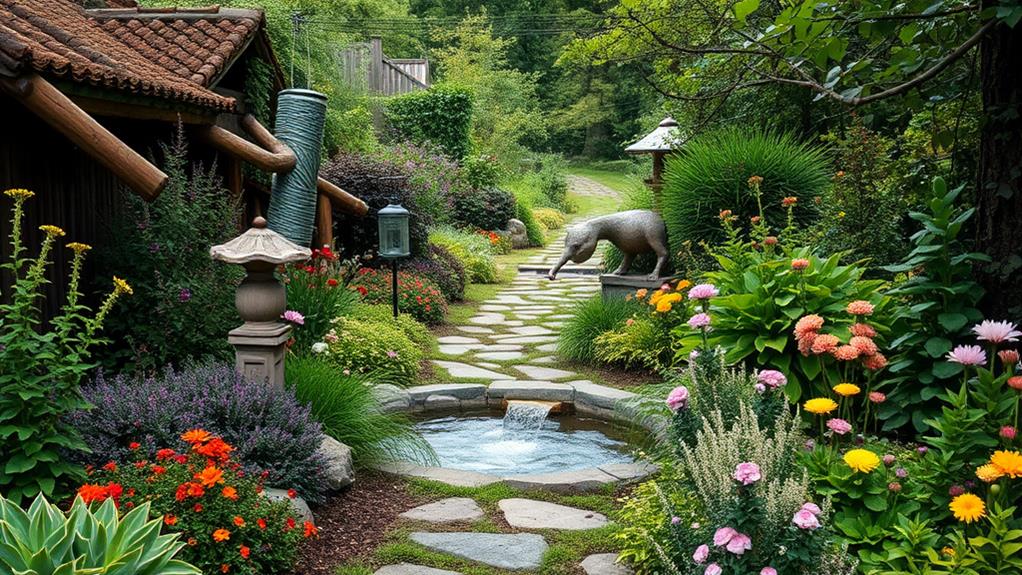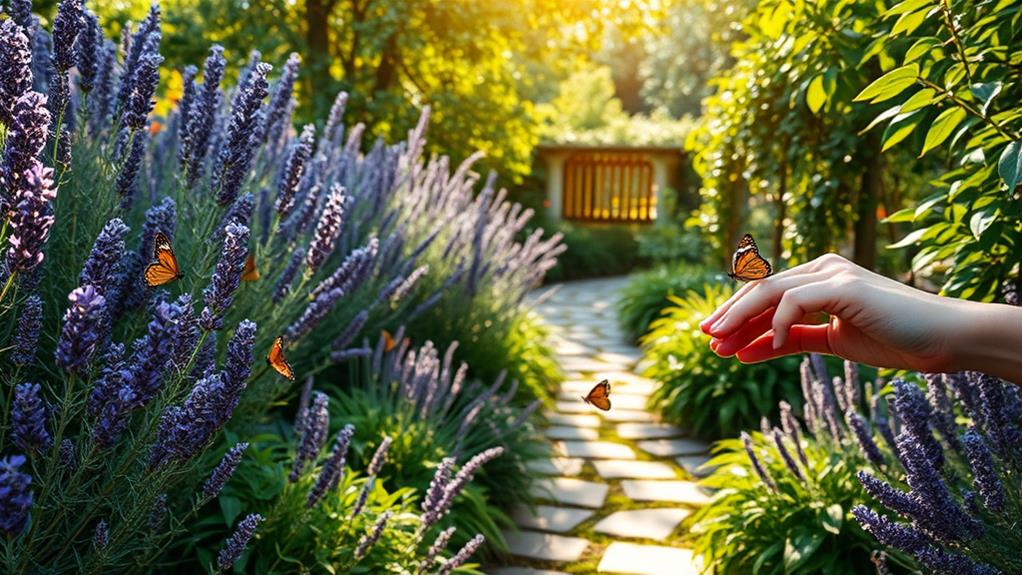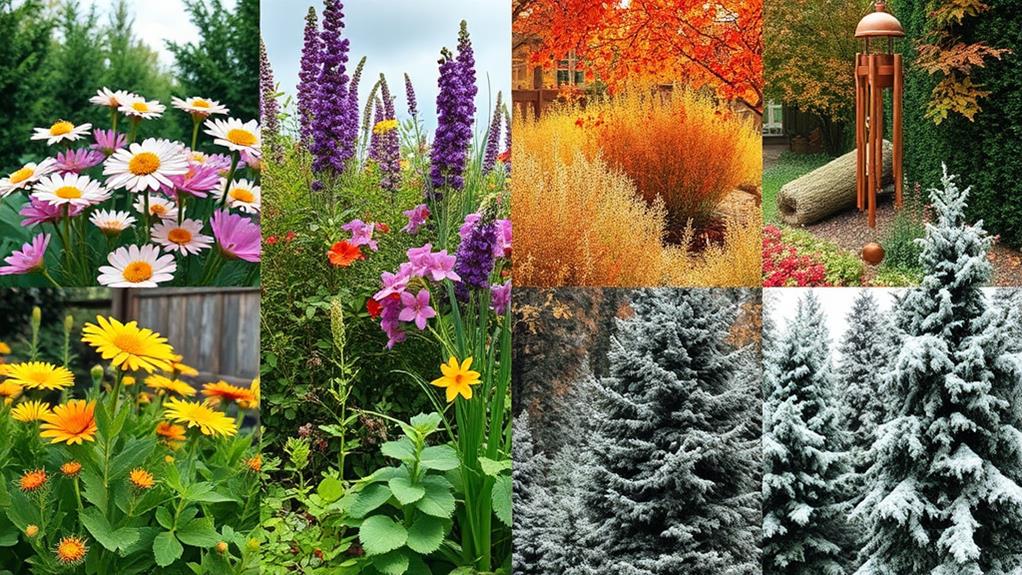Sensory gardens transform outdoor spaces into immersive environments that engage all five senses. These gardens incorporate a holistic approach, carefully selecting and arranging plants, hardscaping, and interactive features to stimulate sight, sound, touch, smell, and taste simultaneously. Visual appeal forms the foundation, with color playing a pivotal role in evoking emotions and creating interest. Fragrant plants, soothing water features, and diverse textures enhance the sensory experience. Edible elements like fruit trees and herb gardens add flavor to the mix. By considering accessibility and seasonal changes, sensory gardens offer year-round enjoyment for visitors of all abilities. Exploring the intricacies of sensory garden design reveals a world of multi-layered outdoor experiences.
Understanding Sensory Garden Design

When approaching sensory garden design, it's essential to consider how each element can stimulate multiple senses simultaneously. This holistic approach ensures a rich, immersive experience for visitors of all abilities. The key is to carefully select and arrange plants, hardscaping, and interactive features that engage sight, sound, touch, smell, and even taste.
Visual appeal remains crucial, but it should be complemented by other sensory elements. Incorporate plants with varied textures, from smooth leaves to rough bark, encouraging tactile exploration. Choose flora with fragrant blooms or aromatic foliage to create olfactory zones throughout the garden.
Introduce auditory elements like wind chimes, water features, or plants that rustle in the breeze. Consider edible plants or herbs to engage the sense of taste.
Thoughtful layout is paramount. Create distinct areas or "rooms" within the garden, each focusing on different sensory experiences. Ensure accessibility with wide, smooth pathways and raised beds for easier interaction. Use contrasting colors and textures in hardscaping to aid navigation for visually impaired visitors.
Stimulating Sight With Color
Visual appeal forms the foundation of any sensory garden, with color playing a pivotal role in stimulating sight and evoking emotions. When renovating for multi-sensory outdoor experiences, carefully consider the color palette to create a visually captivating environment. Utilize a mix of warm and cool hues to establish balance and interest throughout the space.
Incorporate vibrant flowers like red salvias, yellow daffodils, and purple lavender to create focal points and draw attention to specific areas. Softer pastel shades can be used for a calming effect, while bold, contrasting colors can energize and excite visitors. Consider the changing seasons when selecting plants, ensuring year-round visual interest through foliage color variations and blooming cycles.
Beyond plant selection, integrate colorful elements through hardscaping materials, such as painted structures, mosaic tiles, or brightly colored furniture. Use color theory principles to create harmonious combinations or deliberate contrasts that elicit specific emotional responses. Remember that color perception can vary among individuals, especially those with visual impairments, so incorporate a diverse range of hues and textures to enhance the overall sensory experience for all visitors.
Engaging Smell Through Fragrant Plants

While sight may be the primary sense engaged in a garden, the olfactory experience plays a crucial role in creating a truly immersive outdoor environment. Incorporating fragrant plants strategically throughout the landscape can elevate the sensory experience and evoke powerful memories and emotions.
When selecting aromatic plants, consider their bloom times to ensure a continuous fragrant presence throughout the seasons. Popular choices include lavender, jasmine, and roses for summer; hyacinths and lilacs for spring; and witch hazel for winter interest. Herbs like rosemary, thyme, and mint not only provide pleasant scents but also offer culinary benefits.
Placement is key to maximizing olfactory impact. Position fragrant plants near seating areas, pathways, and entrances where their scents can be easily appreciated. Consider prevailing winds to help disperse aromas throughout the garden. Planting in raised beds or containers can bring scents closer to nose level.
For evening enjoyment, include night-blooming plants like evening primrose or moonflower. These species release their fragrances after sunset, adding an enchanting dimension to nighttime garden experiences. By carefully selecting and positioning aromatic plants, gardeners can create a multi-layered sensory landscape that engages the nose as much as the eyes.
Creating Soothing Soundscapes
Sound plays a vital role in shaping the outdoor experience, complementing visual and olfactory elements to create a truly immersive environment. When renovating outdoor spaces, incorporating soothing soundscapes can transform a garden into a tranquil retreat. Water features, such as fountains, cascading streams, or gentle waterfalls, provide a constant, calming background noise that masks urban disturbances and promotes relaxation.
Strategic placement of wind chimes can add melodic tones to the garden, responding to even the slightest breeze. Selecting chimes of different materials and sizes allows for a range of pitches and tones. Bamboo plantings rustle softly in the wind, while ornamental grasses produce a gentle swishing sound when mature.
Creating habitat for local birds through native plantings and bird feeders encourages their presence, bringing natural songs and chirps to the space. Thoughtful hardscaping choices, such as loose gravel pathways, can introduce subtle crunching sounds underfoot. For a more controlled auditory experience, consider installing weatherproof speakers hidden among plantings, allowing for curated nature sounds or soft music to enhance the atmosphere.
Exploring Textures for Touch

Beyond sight and sound, the sense of touch offers a rich dimension to outdoor experiences. Incorporating diverse textures in your garden design can create a tactile journey that engages visitors on a deeper level. Consider integrating smooth river rocks, rough tree bark, soft moss, and velvety leaves to provide a range of sensations.
Strategically place textural elements along pathways or in dedicated sensory zones. Install raised beds with different soil types, from sandy to loamy, allowing hands-on exploration. Incorporate water features with varying surface textures, such as polished stones or rippled metal, to stimulate tactile senses.
Plant selection plays a crucial role in texture exploration. Choose plants with distinct leaf textures, like the fuzzy lamb's ear or the waxy-smooth jade plant. Include grasses that sway in the breeze, inviting touch. For vertical interest, install living walls with a mix of succulents and trailing vines, creating a tapestry of textures at different heights.
Don't forget to include natural materials in hardscaping elements. Use wooden benches, stone pavers, and metal railings to provide contrasting textures throughout the garden. These thoughtful additions will transform your outdoor space into a multi-sensory haven.
Incorporating Edible Elements
Numerous edible elements can transform an outdoor space into a feast for both the senses and the palate. Incorporating fruit trees, berry bushes, and herb gardens not only adds visual interest but also provides opportunities for taste and smell experiences.
Consider planting dwarf fruit trees like apple, pear, or cherry, which offer seasonal blooms and harvestable fruit. Berry bushes such as blueberries, raspberries, or blackberries provide texture and color while yielding sweet treats.
Herb gardens are particularly versatile for sensory engagement. Aromatic herbs like lavender, rosemary, and thyme release scents when brushed against, while culinary herbs such as basil, mint, and cilantro offer both fragrance and flavor. Edible flowers like nasturtiums, pansies, and marigolds add pops of color and can be used in salads or as garnishes.
For vertical interest, consider espaliered fruit trees or hanging strawberry planters. Vegetable gardens, whether in raised beds or containers, provide ongoing sensory experiences from planting to harvest. When planning edible elements, consider companion planting to maximize space and promote plant health. Additionally, ensure all plants are non-toxic and suitable for your climate to create a safe and thriving sensory environment.
Water Features for Sensory Appeal

Water's versatile nature makes it an invaluable element in creating multi-sensory outdoor experiences. Its ability to engage sight, sound, touch, and even smell offers numerous opportunities for sensory enhancement in garden design. Incorporating water features can transform a static landscape into a dynamic, immersive environment that captivates visitors.
Visual appeal is achieved through reflective surfaces, cascading waterfalls, or mist-producing fountains. The movement of water adds a kinetic element, drawing the eye and creating focal points.
Auditory stimulation comes from the diverse sounds water can produce, from gentle trickles to powerful rushes, providing a soothing backdrop or energizing atmosphere.
Tactile experiences are facilitated through accessible water elements like shallow pools or water walls, allowing visitors to interact directly with the cool liquid. Mist features can offer a refreshing sensation on the skin, especially appreciated in warmer climates. The presence of water also influences air temperature and humidity, affecting the overall feel of the space.
When selecting water features, consider maintenance requirements, water conservation, and safety aspects to ensure a sustainable and user-friendly sensory experience.
Accessible Pathways and Structures
Accessible pathways and structures form the foundation of an inclusive multi-sensory outdoor experience. These elements ensure that individuals of all abilities can navigate and enjoy the garden space safely and comfortably.
Wide, level paths with firm, slip-resistant surfaces accommodate wheelchairs, walkers, and strollers. Gentle slopes and strategically placed ramps provide alternatives to steps, while handrails offer support where needed.
Raised garden beds and vertical planting structures bring plants within reach of seated visitors and those with limited mobility. Elevated sensory stations can be incorporated along pathways, featuring tactile elements, aromatic plants, or interactive displays at various heights. Consider installing benches and rest areas at regular intervals, providing opportunities for visitors to pause and fully immerse themselves in the sensory experience.
Proper lighting is crucial for safety and accessibility, especially for those with visual impairments. Use a combination of ambient and focused lighting to illuminate pathways, highlight key features, and extend garden use into evening hours. Signage with large, high-contrast text and braille descriptions further enhances navigation and engagement for all visitors, ensuring a truly inclusive multi-sensory garden experience.
Seasonal Considerations for Year-Round Enjoyment

Designing a multi-sensory outdoor space that captivates visitors throughout the year requires careful consideration of seasonal changes. To ensure year-round enjoyment, incorporate elements that appeal to the senses across different seasons.
In spring, focus on fragrant blossoms and the sound of emerging wildlife. Summer can showcase vibrant colors, textures, and the taste of edible plants. Autumn brings rich foliage hues and the rustling of fallen leaves, while winter offers opportunities for structural interest and the sound of wind through bare branches.
Select plants with varied blooming times and interesting bark or seed heads for visual appeal in all seasons. Install water features that can be enjoyed year-round, such as heated fountains or ice sculptures in winter. Consider adding covered areas or windbreaks to extend outdoor use during inclement weather.
Incorporate lighting to enhance evening experiences and illuminate interesting features during shorter winter days. Lastly, plan for maintenance activities that support sensory experiences, such as raking leaves in autumn or clearing snow in winter, to engage visitors actively in the changing seasons.
Frequently Asked Questions
How Much Does It Typically Cost to Create a Sensory Garden?
The cost to create a sensory garden typically ranges from $5,000 to $50,000, depending on size, materials, and features. Factors influencing price include plant selection, hardscaping, sensory elements, and professional design services if utilized.
Can Sensory Gardens Be Beneficial for Individuals With Specific Medical Conditions?
Oh, surely sensory gardens are just for hippies and wellness gurus, right? Wrong! These therapeutic spaces can significantly benefit individuals with various medical conditions, including autism, dementia, and PTSD, by stimulating senses and promoting relaxation and engagement.
What Maintenance Is Required to Keep a Sensory Garden Thriving?
Maintaining a sensory garden requires regular tasks such as watering, pruning, weeding, and fertilizing. Seasonal plant care, mulching, and pest control are essential. Periodic assessment and replacement of sensory elements ensure the garden remains engaging and accessible year-round.
Are There Any Potential Hazards or Safety Concerns in Sensory Gardens?
By Jove, potential hazards in sensory gardens include toxic plants, sharp objects, and uneven surfaces. Allergens, water features, and overhanging branches also pose risks. Regular safety inspections and proper maintenance are crucial to ensure visitor well-being.
How Long Does It Usually Take to Establish a Fully Functional Sensory Garden?
Establishing a fully functional sensory garden typically takes 1-3 years. This timeframe allows for plant growth, hardscape installation, and sensory element integration. Factors like garden size, complexity, and climate can influence the duration of development.
Conclusion
Sensory gardens weave a tapestry of experiences, engaging visitors through a symphony of sights, scents, sounds, textures, and tastes. By thoughtfully incorporating diverse elements—from vibrant blooms to trickling fountains—these spaces foster inclusivity and promote wellbeing for all. Careful planning ensures year-round appeal, with accessible design inviting exploration regardless of ability. As living canvases, sensory gardens cultivate connections between people and nature, offering a rich palette of sensations that nourish the body, mind, and spirit in our increasingly urbanized world.

